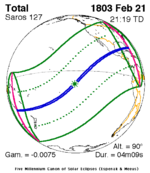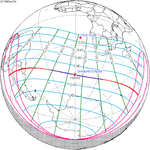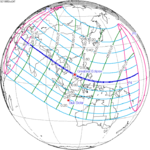
A total solar eclipse occurred at the Moon's ascending node of orbit between Tuesday, February 13 and Wednesday, February 14, 1934, with a magnitude of 1.0321. A solar eclipse occurs when the Moon passes between Earth and the Sun, thereby totally or partly obscuring the image of the Sun for a viewer on Earth. A total solar eclipse occurs when the Moon's apparent diameter is larger than the Sun's, blocking all direct sunlight, turning day into darkness. Totality occurs in a narrow path across Earth's surface, with the partial solar eclipse visible over a surrounding region thousands of kilometres wide. Occurring only 1.6 days after perigee, the Moon's apparent diameter was smaller.

A total solar eclipse occurred at the Moon's descending node of orbit on Tuesday, November 12, 1985, with a magnitude of 1.0388. A solar eclipse occurs when the Moon passes between Earth and the Sun, thereby totally or partly obscuring the image of the Sun for a viewer on Earth. A total solar eclipse occurs when the Moon's apparent diameter is larger than the Sun's, blocking all direct sunlight, turning day into darkness. Totality occurs in a narrow path across Earth's surface, with the partial solar eclipse visible over a surrounding region thousands of kilometres wide. Occurring about 2 hours after perigee, the Moon's apparent diameter was larger. Perigee did occur during the early portion of the eclipse.

A total solar eclipse will occur at the Moon's ascending node of orbit on Saturday, December 5, 2048, with a magnitude of 1.044. A solar eclipse occurs when the Moon passes between Earth and the Sun, thereby totally or partly obscuring the image of the Sun for a viewer on Earth. A total solar eclipse occurs when the Moon's apparent diameter is greater than the Sun's, blocking all direct sunlight. Totality occurs in a narrow path across Earth's surface, with the partial solar eclipse visible over a surrounding region thousands of kilometres wide. Occurring about 16.5 hours before perigee, the Moon's apparent diameter will be larger.

A total solar eclipse will occur at the Moon's ascending node of orbit between Thursday, December 16 and Friday, December 17, 2066, with a magnitude of 1.0416. A solar eclipse occurs when the Moon passes between Earth and the Sun, thereby totally or partly obscuring the image of the Sun for a viewer on Earth. A total solar eclipse occurs when the Moon's apparent diameter is larger than the Sun's, blocking all direct sunlight, turning day into darkness. Totality occurs in a narrow path across Earth's surface, with the partial solar eclipse visible over a surrounding region thousands of kilometres wide. Occurring about 18.5 hours before perigee, the Moon's apparent diameter will be larger.

A total solar eclipse occurred at the Moon's ascending node of orbit on Sunday, October 12, 1958, with a magnitude of 1.0608. A solar eclipse occurs when the Moon passes between Earth and the Sun, thereby totally or partly obscuring the image of the Sun for a viewer on Earth. A total solar eclipse occurs when the Moon's apparent diameter is larger than the Sun's, blocking all direct sunlight, turning day into darkness. Totality occurs in a narrow path across Earth's surface, with the partial solar eclipse visible over a surrounding region thousands of kilometres wide. Occurring about 5.5 hours before perigee, the Moon's apparent diameter was larger.

A total solar eclipse will occur at the Moon's ascending node of orbit on Monday, July 13, 2037, with a magnitude of 1.0413. A solar eclipse occurs when the Moon passes between Earth and the Sun, thereby totally or partly obscuring the image of the Sun for a viewer on Earth. A total solar eclipse occurs when the Moon's apparent diameter is larger than the Sun's, blocking all direct sunlight, turning day into darkness. Totality occurs in a narrow path across Earth's surface, with the partial solar eclipse visible over a surrounding region thousands of kilometres wide. Occurring about 2.6 days before perigee, the Moon's apparent diameter will be larger.

A total solar eclipse will occur at the Moon's descending node of orbit on Thursday, December 15, 2039, with a magnitude of 1.0356. A solar eclipse occurs when the Moon passes between Earth and the Sun, thereby totally or partly obscuring the image of the Sun for a viewer on Earth. A total solar eclipse occurs when the Moon's apparent diameter is larger than the Sun's, blocking all direct sunlight, turning day into darkness. Totality occurs in a narrow path across Earth's surface, with the partial solar eclipse visible over a surrounding region thousands of kilometres wide. Occurring about 4.5 hours before perigee, the Moon's apparent diameter will be larger.

A total solar eclipse occurred at the Moon's ascending node of orbit on Wednesday, October 23, 1957, with a magnitude of 1.0013. A solar eclipse occurs when the Moon passes between Earth and the Sun, thereby totally or partly obscuring the image of the Sun for a viewer on Earth. A total solar eclipse occurs when the Moon's apparent diameter is larger than the Sun's, blocking all direct sunlight, turning day into darkness. Totality occurs in a narrow path across Earth's surface, with the partial solar eclipse visible over a surrounding region thousands of kilometres wide. Occurring about 1.4 days after perigee, the Moon's apparent diameter was larger.

A total solar eclipse will occur at the Moon's ascending node of orbit on Saturday, July 24, 2055, with a magnitude of 1.0359. A solar eclipse occurs when the Moon passes between Earth and the Sun, thereby totally or partly obscuring the image of the Sun for a viewer on Earth. A total solar eclipse occurs when the Moon's apparent diameter is larger than the Sun's, blocking all direct sunlight, turning day into darkness. Totality occurs in a narrow path across Earth's surface, with the partial solar eclipse visible over a surrounding region thousands of kilometres wide. Occurring about 2.9 days before perigee, the Moon's apparent diameter will be larger.

A total solar eclipse will occur at the Moon's descending node of orbit on Wednesday, January 16, 2075, with a magnitude of 1.0311. A solar eclipse occurs when the Moon passes between Earth and the Sun, thereby totally or partly obscuring the image of the Sun for a viewer on Earth. A total solar eclipse occurs when the Moon's apparent diameter is larger than the Sun's, blocking all direct sunlight, turning day into darkness. Totality occurs in a narrow path across Earth's surface, with the partial solar eclipse visible over a surrounding region thousands of kilometres wide. Occurring about 1.5 days after perigee, the Moon's apparent diameter will be larger.

A total solar eclipse occurred at the Moon's descending node of orbit between Tuesday, October 21 and Wednesday, October 22, 1930, with a magnitude of 1.023. A solar eclipse occurs when the Moon passes between Earth and the Sun, thereby totally or partly obscuring the image of the Sun for a viewer on Earth. A total solar eclipse occurs when the Moon's apparent diameter is larger than the Sun's, blocking all direct sunlight, turning day into darkness. Totality occurs in a narrow path across Earth's surface, with the partial solar eclipse visible over a surrounding region thousands of kilometres wide. Occurring about 2.6 days after perigee, the Moon's apparent diameter was larger.

A total solar eclipse will occur at the Moon's descending node of orbit on Saturday, January 16, 2094, with a magnitude of 1.0342. A solar eclipse occurs when the Moon passes between Earth and the Sun, thereby totally or partly obscuring the image of the Sun for a viewer on Earth. A total solar eclipse occurs when the Moon's apparent diameter is larger than the Sun's, blocking all direct sunlight, turning day into darkness. Totality occurs in a narrow path across Earth's surface, with the partial solar eclipse visible over a surrounding region thousands of kilometres wide. Occurring about 10.5 hours before perigee, the Moon's apparent diameter will be larger.

A total solar eclipse will occur at the Moon's ascending node of orbit between Monday, October 3 and Tuesday, October 4, 2089, with a magnitude of 1.0333. A solar eclipse occurs when the Moon passes between Earth and the Sun, thereby totally or partly obscuring the image of the Sun for a viewer on Earth. A total solar eclipse occurs when the Moon's apparent diameter is larger than the Sun's, blocking all direct sunlight, turning day into darkness. Totality occurs in a narrow path across Earth's surface, with the partial solar eclipse visible over a surrounding region thousands of kilometres wide. Occurring about 2.3 days after perigee, the Moon's apparent diameter will be larger.

A total solar eclipse will occur at the Moon's descending node of orbit on Wednesday, April 21, 2088, with a magnitude of 1.0474. A solar eclipse occurs when the Moon passes between Earth and the Sun, thereby totally or partly obscuring the image of the Sun for a viewer on Earth. A total solar eclipse occurs when the Moon's apparent diameter is larger than the Sun's, blocking all direct sunlight, turning day into darkness. Totality occurs in a narrow path across Earth's surface, with the partial solar eclipse visible over a surrounding region thousands of kilometres wide. Occurring about 1.8 days before perigee, the Moon's apparent diameter will be larger.

A total solar eclipse occurred at the Moon's ascending node of orbit on Sunday, April 16, 1893, with a magnitude of 1.0556. A solar eclipse occurs when the Moon passes between Earth and the Sun, thereby totally or partly obscuring the image of the Sun for a viewer on Earth. A total solar eclipse occurs when the Moon's apparent diameter is larger than the Sun's, blocking all direct sunlight, turning day into darkness. Totality occurs in a narrow path across Earth's surface, with the partial solar eclipse visible over a surrounding region thousands of kilometres wide. Occurring about 1.3 days before perigee, the Moon's apparent diameter was larger.

A total solar eclipse occurred at the Moon's descending node of orbit on Tuesday, September 7, 1858, with a magnitude of 1.0210. A solar eclipse occurs when the Moon passes between Earth and the Sun, thereby totally or partly obscuring the image of the Sun for a viewer on Earth. A total solar eclipse occurs when the Moon's apparent diameter is larger than the Sun's, blocking all direct sunlight, turning day into darkness. Totality occurs in a narrow path across Earth's surface, with the partial solar eclipse visible over a surrounding region thousands of kilometres wide. Occurring about 2.5 days after perigee, the Moon's apparent diameter was larger.

A total solar eclipse occurred at the Moon's ascending node of orbit on Thursday, October 12, 1939, with a magnitude of 1.0266. A solar eclipse occurs when the Moon passes between Earth and the Sun, thereby totally or partly obscuring the image of the Sun for a viewer on Earth. A total solar eclipse occurs when the Moon's apparent diameter is larger than the Sun's, blocking all direct sunlight, turning day into darkness. Totality occurs in a narrow path across Earth's surface, with the partial solar eclipse visible over a surrounding region thousands of kilometres wide. Occurring about 1.8 days after perigee, the Moon's apparent diameter was larger.

A total solar eclipse occurred at the Moon's ascending node of orbit on Saturday, October 1, 1921, with a magnitude of 1.0293. A solar eclipse occurs when the Moon passes between Earth and the Sun, thereby totally or partly obscuring the image of the Sun for a viewer on Earth. A total solar eclipse occurs when the Moon's apparent diameter is larger than the Sun's, blocking all direct sunlight, turning day into darkness. Totality occurs in a narrow path across Earth's surface, with the partial solar eclipse visible over a surrounding region thousands of kilometres wide. Occurring about 1.9 days after perigee, the Moon's apparent diameter was larger.

A total solar eclipse occurred at the Moon's ascending node of orbit on Thursday, August 29, 1867, with a magnitude of 1.0344. A solar eclipse occurs when the Moon passes between Earth and the Sun, thereby totally or partly obscuring the image of the Sun for a viewer on Earth. A total solar eclipse occurs when the Moon's apparent diameter is larger than the Sun's, blocking all direct sunlight, turning day into darkness. Totality occurs in a narrow path across Earth's surface, with the partial solar eclipse visible over a surrounding region thousands of kilometres wide. Occurring about 2.5 days after perigee, the Moon's apparent diameter was larger.

A total solar eclipse occurred at the Moon's descending node of orbit on Wednesday, November 30, 1853, with a magnitude of 1.0485. A solar eclipse occurs when the Moon passes between Earth and the Sun, thereby totally or partly obscuring the image of the Sun for a viewer on Earth. A total solar eclipse occurs when the Moon's apparent diameter is larger than the Sun's, blocking all direct sunlight, turning day into darkness. Totality occurs in a narrow path across Earth's surface, with the partial solar eclipse visible over a surrounding region thousands of kilometres wide. Occurring about 8.5 hours before perigee, the Moon's apparent diameter was larger.


























































































































